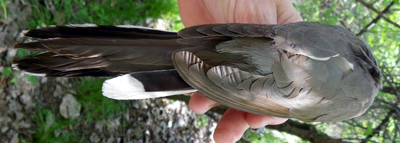 |
| PROW male |
The weather is shaping up for the last pulse of the third wave occurring by mid-week. This will bring in the last peak of the flycatchers, Red-eyed Vireos (REVI), Mourning Warbler (MOWA), Blackpoll Warbler (BLPW), Wilson Warbler (WIWA) and the elusive Connecticut Warbler (CONW).
 |
| PROW male back-note white tail spots |
Highlights for the week:
 |
| Yellow-billed Cuckoo (YBCU)-note rufous wings |
 |
| YBCU-note tail spots |
Here's a reminder that bird plumage does not always follow examples of field marks you will find in the field guide:
 |
| Wilson Warbler male with many yellow feathers in his cap |
 |
| WIWA back |
 |
| Male Yellow-breasted Chat (YBCH). How do we know it's a male? Males have black mouth lining while females have pink. |
 |
| Scarlet Tanager (SCTA) female. Note greenish yellow body color versus golden yellow body feathers of a female Summer Tanager. |
 |
| Olive-sided Flycatcher (OSFL) back. Not showing the white tufts emphasized in field guides. |
 |
| OSFL front view. Note the dark gray vest it is wearing. This may be a better field mark than the white on its back. The song/call is more telling as well. |
 |
| Philadelphia Vireo (PHVI) back- note the white superciliary line. |
 |
| PHVI: note its lemon yellow throat and belly. |
and Kenn Kaufman's Migration forecast at http://cranecreekbirding.blogspot.com/
Get outside and enjoy the last migrants of spring!

No comments:
Post a Comment